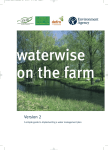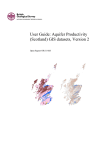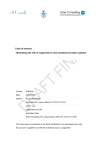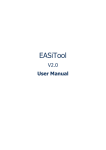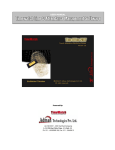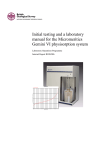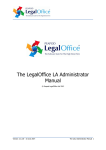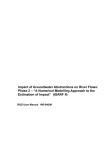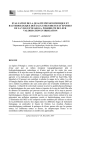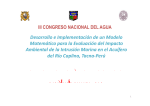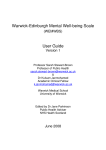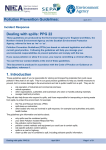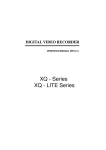Download WAT-RM-16 Groundwater Abstractions
Transcript
Water Use Regulatory Method (WAT-RM-16) Hydrogeologist Input to Groundwater Abstraction Assessment Version: v4 Released: Mar 2013 Copyright and Legal Information Copyright© 2013 Scottish Environment Protection Agency (SEPA). All rights reserved. No part of this document may be reproduced in any form or in any means, electronic or mechanical, including (but not limited to) photocopying, recording or by any information storage and retrieval systems, without the express permission in writing of SEPA. Disclaimer Whilst every effort has been made to ensure the accuracy of this document, SEPA cannot accept and hereby expressly excludes all or any liability and gives no warranty, covenant or undertaking (whether express or implied) in respect of the fitness for purpose of, or any error, omission or discrepancy in, this document and reliance on contents hereof is entirely at the user’s own risk. Registered Trademarks All registered trademarks used in this document are used for reference purpose only. Other brand and product names maybe registered trademarks or trademarks of their respective holders. Update Summary Version Description v1.0 First issue for Water Use reference using approved content from the following documents: GWABS_8_v1_19_Hydrogeologist_Input_to _the_assessment_of_Groundwater_Abstraction_Impacts.doc v2.0 Changes made to reflect difference in abstraction rate for the simple/complex licence cut-off v2.1 Header info revised, minor typos corrected. v3 Doc simplified to remove repeated info and updated to reflect changes to WATRM-11 and revised Form references.. v4 Expired CMS links reviewed and updated. Notes References: Linked references to other documents have been disabled in this web version of the document. See the References section for details of all referenced documents. Printing the Document: This document is uncontrolled if printed and is only intended to be viewed online. If you do need to print the document, the best results are achieved using Booklet printing or else double-sided, Duplex (2-on-1) A4 printing (both four pages per A4 sheet). Always refer to the online document for accurate and up-to-date information. 2 of 40 Uncontrolled if printed v4 Mar 2013 Table of Contents 1. Introduction......................................................................................................... 5 1.1 Purpose.................................................................................................... 5 1.2 Scope ....................................................................................................... 5 1.3 Legislative Context ................................................................................... 5 2. Principles of Environmental Impact Assessment for Groundwater Abstractions. 6 2.1 Introduction .............................................................................................. 6 2.2 Groundwater Quantitative Status ............................................................. 6 2.3 Screening Assessment............................................................................. 6 2.4 Further Assessment ................................................................................. 7 2.5 Formulation of licence conditions ............................................................. 9 2.6 Groundwater Unit Input to Process .......................................................... 9 2.7 Conceptual Modelling............................................................................... 9 3. Groundwater Dependent Terrestrial Ecosystems (GWDTE) ............................ 11 3.1 Overview ................................................................................................ 11 3.2 Core Assumptions .................................................................................. 11 3.3 Screening Assessment Review .............................................................. 11 3.4 Further Assessment ............................................................................... 12 3.5 Assessment of Information Provided by the Applicant ........................... 13 3.6 Formulation of Licence Conditions ......................................................... 13 4. Other Abstractions ............................................................................................ 14 4.1 Overview ................................................................................................ 14 4.2 Core Assumptions .................................................................................. 14 4.3 Screening Assessment Review .............................................................. 14 4.4 Further Assessment ............................................................................... 15 4.5 The Formulation of Licence Conditions .................................................. 16 5. Impacts on Flowing Surface Waters ................................................................. 18 5.1 Overview ................................................................................................ 18 5.2 Standing Surface Waters ....................................................................... 18 v4 Mar 2013 Uncontrolled if printed 3 of 40 Regulatory Method (WAT-RM-16) 5.3 Core Assumptions .................................................................................. 18 5.4 Screening Assessment Review .............................................................. 19 5.5 Further Assessment ............................................................................... 20 5.6 Formulating Licence Conditions ............................................................. 21 6. Saline Intrusion ................................................................................................. 23 6.1 Overview ................................................................................................ 23 6.2 Core Assumptions .................................................................................. 23 6.3 Screening Assessment Review .............................................................. 23 6.4 Further Assessment ............................................................................... 24 6.5 Formulating Licence Conditions ............................................................. 26 7. Insufficient Resource ........................................................................................ 28 7.1 Overview ................................................................................................ 28 7.2 Core Assumptions .................................................................................. 28 7.3 Screening Assessment Review .............................................................. 29 7.4 Further Assessment ............................................................................... 29 7.5 Formulating Licence Conditions. ............................................................ 31 Appendix 1: IGARF ........................................................................................... 33 Appendix 2: Values of T&S Used in Low Flows 2000 ....................................... 35 Appendix 3: Saline Intrusion Assessment......................................................... 37 References ........................................................................................................... 39 4 of 40 Uncontrolled if printed v4 Mar 2013 1. Introduction 1.1 Purpose This document aims to provide guidance for SEPA Groundwater Unit staff on how to assess of potential environmental impact of a groundwater abstraction and determine if this complies with the WFD. This guidance also provides an understanding of the way in which SEPA considers abstraction impacts and so may be useful to anyone involved with estimating impacts from groundwater abstractions, such as environmental consultants. 1.2 Scope This document deals with the sort of further information which may be required from the applicant to determine a groundwater abstraction application as well as assessment of this information to decide if the abstraction is acceptable. The assessment process is not designed to undertake estimates of, or guarantee, well yields. The guidance has been written with respect to licence applications but the principles will also be relevant to anyone assessing a registration level abstraction in a sensitive location. 1.3 Legislative Context The Water Environment and Water Services (Scotland) Act 2003 (WEWS) transposed the principles of the European Directive 2000/60/EC (known as the Water Framework Directive or WFD) into Scots law. The Water Environment (Controlled Activities) (Scotland) Regulations (CAR), provide the framework of control necessary for groundwater abstractions as required under the WFD. WEWS makes SEPA the responsible body for assessment and regulation of abstractions such that the requirements of WEWS, CAR, and hence the WFD, are met. v4 Mar 2013 Uncontrolled if printed 5 of 40 2. Principles of Environmental Impact Assessment for Groundwater Abstractions 2.1 Introduction The groundwater abstraction licence assessment process is designed to help Scotland meet the objectives of the WFD. This assessment is undertaken at two levels: Screening assessment Further assessment following site-specific investigations if required. The tests are designed to see if the abstraction is likely to result in a deterioration in status of Scotlands groundwater bodies. 2.2 Groundwater Quantitative Status Good quantitative status of groundwater is achieved if: There is a surplus of resource over abstraction There is no long term decrease in groundwater level Groundwater abstraction causes no failure in ecological objectives for any associated surface waters, or diminution in status, or prevents the return to good ecological status of such waters Groundwater abstraction causes no significant damage to directly supported terrestrial ecosystems There is no saline or other intrusion In addition the WFD aims to safeguard and develop the potential uses of Community waters. 2.3 Screening Assessment A series of screening tests needs to be carried out by EPI to assess the licence application. This is detailed in WAT-RM-11: Licensing Groundwater Abstractions including Dewatering. For licences the assessment is based upon a survey of water features undertaken by the applicant in conjunction with SEPA datasets (e.g. registered and licensed abstractions). For licences the assessment is based upon a survey of water features detailed in WAT-FORM-10: Water Features Survey Identification Form (GW), undertaken by the applicant in conjunction with SEPA datasets (e.g. registered and licensed abstractions). The results of each screening test should be recorded in WAT-FORM-11: Groundwater Abstraction Application Screening Assessment. The screening assessment is designed to examine 6 of 40 Uncontrolled if printed v4 Mar 2013 Principles of Environmental Impact Assessment for Groundwater Abstractions the effects that an abstraction might have which could lead to a failure of WFD objectives. The tests are as follows: Surface water Flow Impact Assessment (environmental standards test) Potential saline intrusion Adequate Resource test (consult the Groundwater Unit) Existing abstractions within survey radius Wetlands within survey radius England Scotland border within survey area. In such cases, the consultative procedure with the EA is triggered. This ensures that any potential problems to the water environment in the Solway Tweed River Basin Districts are identified. Each of the above tests are based upon a set of core assumptions. If potential impacts are identified as a result of the screening assessment and the abstraction cannot be moved or the volume reduced to remove or lessen the impact of the abstraction the applicant will be asked to undertake further site specific investigations. These investigations are designed to demonstrate the validity or otherwise of the core assumptions, for this particular abstraction. Where a potential significant impact is identified the applicant may be able to supply socio-economic justification for the abstraction. This assessment will be undertaken by EPI. 2.4 Further Assessment 2.4.1 Information to be submitted by the applicant The Groundwater Unit should detail the further information required from the applicant to determine the application on WAT-FORM-12: Groundwater Abstraction Further Information Requirements. EPI will then use this information to specify investigation requirements. In some cases the applicant may wish to test the borehole for a longer period than we require e.g. for yield testing. SEPA should aim to accommodate any requests of this kind where this is unlikely to cause unacceptable environmental impacts. Advice may be sought from Ecology where the presence of a groundwater dependent wetland is the reason for failure. For licence applications the applicant must submit the data and an interpretative report consisting of: Conceptual model constructed using real data as appropriate Quantification of impact v4 Mar 2013 Uncontrolled if printed 7 of 40 Regulatory Method (WAT-RM-16) Assessment of any reduction in flow, water level or nutrients as appropriate 2.4.2 Assessment of Information Provided by the Applicant When assessing the further information supplied by the applicant e.g. test pumping information or further details on wetlands, you should make use of WAT-FORM-14: Hydrogeologist Input to Groundwater Abstraction Assessment. EPI will only refer those applications for abstraction to you if the interpretative report submitted by the applicant is not of the required quality, does not supply the information required or identifies a potential impact. In such cases you will need to examine the report in detail. Your objective is to determine if investigation demonstrates that the hydrogeological assumptions are not justified, and the findings are backed with appropriate data. Your examination may need to include some or all of the following: Examination of the conceptual model and in particular the information used to validate it Analysis of test pumping interpretation to check that the most appropriate aquifer properties have been used in modelling Examination of data to check that the interpretation of the hydrogeological conditions is justified Where relevant, examination of any flow apportioning where the evidence supports a contribution from more than one surface water Where relevant, quantification of impact by calculation or modelling of risk of intrusion, e.g. Appendix 2 in relation to the short term measurement and long term prediction of groundwater quality trends induced by pumping. Where relevant an assessment of significance of any further reduction in available resource, e.g. surface water flow impacts. Consultation with Wetland Ecology if wetlands are identified within the survey area Having assessed the hydrogeological data and the interpretative report for adequacy and accuracy you should prepare a short report using WATFORM-14: Hydrogeologist Input to Groundwater Abstraction Assessment which you should send to EPI who will decide if the abstraction may be authorised. Any recommendation to refuse the permit application should be justified in full. 8 of 40 Uncontrolled if printed v4 Mar 2013 Principles of Environmental Impact Assessment for Groundwater Abstractions 2.5 Formulation of licence conditions You may be asked by EPI to describe conditions that could be added to the licence to allow authorisation of the abstraction. If you consider that the impact could be significant then site specific conditions on the licence may allow the abstraction to be authorised. This should be detailed on WATFORM-14: Hydrogeologist Input to Groundwater Abstraction Assessment which should be sent to EPI. If you decide that adequate conditions cannot be applied to protect the receptor the abstraction may still be authorised if the applicant can demonstrate socio-economic justification and this option should be included in your report. The assessment of socio-economic justification will be undertaken by EPI. 2.6 Groundwater Unit Input to Process The Groundwater Unit may be asked to advise the process at a number of stages of an application: You may be asked to advise EPI on groundwater resource availability as part of the screening assessment. If the screening assessment identifies a potential impact you may be asked to review the failed test Where a potential impact is confirmed, and the applicant has agreed to supply further information, you may be asked to define the scope of an investigation. Consultation with ecology on this is appropriate where wetlands may be impacted. You may be asked to review and comment on an interpretative report submitted in support of an application to abstract groundwater . Consultation with ecology on this is appropriate where wetlands may be impacted. Sections 3 to 7 provide further information on each assessment test and Groundwater Unit input to them. 2.7 Conceptual Modelling You will need to construct a conceptual model of sufficient detail at each input level. The guidance document WAT-RM-27: Modelling Methods for Groundwater Abstractions gives more information on the construction of conceptual models. An appropriate conceptual model will normally be constructed from information held on GIS and any other relevant information of which you are aware, e.g. local borehole logs or groundwater level data, in order to confirm that the basic assumptions underlying each test apply to the application. It is important to note that whilst the basic screening will be done using a v4 Mar 2013 Uncontrolled if printed 9 of 40 Regulatory Method (WAT-RM-16) standard assumption of radial flow, local geological structures or other natural or man-made features may cause non-radial flow. This should be taken into account in your conceptual model. The development of the conceptual model needs inclusion of wetlands and their hydro-ecological functioning, where wetlands are associated with any potential impact. Advice from Ecology needs to be sought on this. 10 of 40 Uncontrolled if printed v4 Mar 2013 3. Groundwater Dependent Terrestrial Ecosystems (GWDTE) 3.1 Overview The protection of Groundwater Dependent Terrestrial Ecosystems (GWDTEs) is an objective of the WFD and is one of the components of groundwater status. The overall decision concerning the significance of an impact will be made by Wetland Ecology supported by the Groundwater Unit and Hydrology. Impacts on GWDTEs may be induced by the new groundwater abstraction as a result of changes to surface water flows or groundwater levels. Significant groundwater level impacts will be more likely where these ecosystems are located close to the proposed abstraction as the drawdown of the water table decreases with distance from the abstraction. The key issues for which the Groundwater Unit may be consulted are: Changes in groundwater level induced by drawdown Changes in surface water flow, particularly spring flow, as a result of a reduction in the available resource Changes in the natural seasonal variations to the groundwater regime Changes in the supply of essential nutrients 3.2 Core Assumptions Until regulatory standards are approved the screening assessment for wetlands is based on the following assumptions: There is hydraulic continuity between the wetland (GWDTE) and the groundwater body The wetland (GWDTE) is groundwater dependent The wetland (GWDTE) is sensitive to changes in water level or flow from groundwater within the groundwater body Following development of regulatory standards these assumptions may be revised. 3.3 Screening Assessment Review Where the screening assessment identifies a wetland consult wetland ecology specialists. v4 Mar 2013 Uncontrolled if printed 11 of 40 Regulatory Method (WAT-RM-16) 3.4 Further Assessment 3.4.1 Information to be Supplied by the Applicant Where the applicant has agreed in principle to undertake an investigation then, to demonstrate that the core assumptions are not valid, they will need to either: Provide evidence of the presence of a hydrogeological barrier between the groundwater body and wetland Provide evidence that there will be no hydraulic impact or that the hydraulic impact will not cause significant damage Provide evidence that the ecology of the wetland does not include those communities associated with groundwater dependency and/or evidence that the hydrogeological conditions are such at the wetland is not water dependent. The applicant will therefore need to supply data obtained from one or more of the following: Measurements that demonstrate that the groundwater table lies at such a depth that the groundwater body cannot be contributing to the wetland. Examination of the standing water level in the abstraction borehole and, in most cases an additional observation borehole is likely to be needed, located as close to the site as possible. Borehole logs or hydrogeological sources that establish the presence and extent of a low permeability barrier between the wetland and the groundwater body. Information may be gathered from the abstraction borehole log and in most cases evidence is also likely to be needed from other boreholes closer to the site. Test pumping and groundwater level monitoring to assess the long term drawdown or flow reduction which will occur if the abstraction took place, including the seasonality of the drawdown/reduction in flow. Monitoring of the pumping borehole and in most cases an observation well into the aquifer and lying as close as possible to the edge of the GWDTE is likely to be necessary. Data or prediction of seasonality of drawdown must be submitted by the applicant. Identification and location of sensitive species to demonstrate that these do not include communities that are normally assumed to indicate groundwater dependency. (The investigation, and therefore the contents of the relevant part of the notice or the licence conditions, must be defined and assessed by Ecology.) Investigations to demonstrate that there will be no significant damage to the wetland as a result of any change in the supply of nutrients to the site. This will normally need to be linked to some estimation of flow 12 of 40 Uncontrolled if printed v4 Mar 2013 Groundwater Dependent Terrestrial Ecosystems (GWDTE) changes derived from monitoring of surface water or ground water flow. Where potential flow impacts have been identified you may need to use IGARF to determine the proportion of the abstraction that should be allocated to the surface water. For more details on flow allocation, refer to: • Section 5: Impacts on Flowing Surface Waters • Appendix 1: IGARF • IGARF User Manual In some instances, e.g. where the GWDTE is some distance from the abstraction, the effects of the abstraction may not occur for some time (perhaps months or even years in the future). However, modelling with test pump data should be able to predict any impacts. Where there is still considerable uncertainty a long term (e.g. at least one year) time limited licence including monitoring can be issued prior to issue of a full abstraction licence. 3.5 Assessment of Information Provided by the Applicant Wetland regulatory standards are not yet available. Until these have been developed Wetland Ecology will advise the significance or otherwise of the impact on a site specific basis. 3.6 Formulation of Licence Conditions If Wetland Ecology is satisfied that there will be no impacts or that any impacts will not cause significant damage to the site then no site specific conditions will be required on the licence. If Wetland Ecology decides that significant impacts are possible but unlikely, the Groundwater Unit should define long term monitoring of groundwater levels and/or spring flows for conditions of any authorisation. You may also wish to consider the addition of groundwater quality monitoring to ensure that an adequate supply of nutrients is maintained. If Wetland Ecology decides that there may be significant impacts you may be consulted to decide if it is possible to authorise the abstraction by using conditions on the licence. These may include: “Hands off” conditions, i.e. abstraction must cease when surface water flow or level or groundwater level reaches a predetermined point Restricted abstraction, i.e. abstraction is restricted to a predetermined amount when surface water flow or level or groundwater level reaches a predetermined point Temporal restrictions which restrict the abstraction to specified periods, e.g. winter only. v4 Mar 2013 Uncontrolled if printed 13 of 40 4. Other Abstractions 4.1 Overview It is SEPA policy to protect other users of groundwater and an objective of the WFD the provision of the sufficient supply of good quality surface water and groundwater as needed for sustainable, balanced and equitable water use. In general, other abstractors of groundwater are the users most likely to be impacted by a new abstraction as a result of changes to groundwater levels. Reduction of groundwater level by a new abstraction may, in extreme cases, result in the groundwater level being reduced close to or below the level of the pump intake of another abstraction, thus prohibiting extraction of groundwater. Examination of drawdown effects will therefore be the key issue for the Groundwater Unit. Significant impacts will be more likely where other abstractions are located close to the proposed abstraction as the fall in groundwater level diminishes with distance from the abstraction. Further consideration of a potential impact identified during screening will need input from the Groundwater Unit for: Determination of hydrogeological connection Pumping test and monitoring design and evaluation Assessment of the significance of changes to groundwater levels Determination of appropriate licence conditions 4.2 Core Assumptions There are no regulatory standards for assessing impacts on existing abstractors. The screening assessment for the impact on other abstractions is based upon the following core assumptions: There is hydraulic continuity between the abstractions The reduction in groundwater level will impact the existing abstraction, i.e. the radius of impact used in the screening assessment is appropriate The aquifer is homogeneous/isotropic 4.3 Screening Assessment Review Where EPI asks for a review of the screening assessment because of an identified potential impact you should use GIS and any other information of which you are aware, e.g. geological maps, to determine if the core assumptions are justified. You should examine the geological evidence to determine if hydraulic continuity between the abstractions may be poor or unlikely. This may be due to the presence of a hydraulic barrier, such as a dyke, or a change in geology. You need to consider that, even where both abstractions are from productive aquifers, the difference in properties may mean that the impact is significantly reduced, e.g. a new abstraction from 14 of 40 Uncontrolled if printed v4 Mar 2013 Other Abstractions river gravels may not significantly impact on a neighbouring abstraction into sandstones. You should enter your decision on WAT-FORM-12: Groundwater Abstraction Further Information Requirements and return the form and the application to EPI. Where potential significant impacts have been identified EPI will then contact the applicant to determine if they are willing to move the abstraction or reduce the abstraction volume so as to remove the risk. Where the applicant is unwilling or unable to do either then, for the application to proceed, investigations must be undertaken to test the core assumptions. 4.4 Further Assessment 4.4.1 Information to be Supplied by the Applicant To demonstrate that the core assumptions are not valid, the applicant will need to either: Provide evidence of the presence of a hydrogeological barrier between the groundwater body and abstraction, or Provide evidence that there will be no significant drawdown effects or that the drawdown will not inhibit normal abstraction from the potentially impacted borehole. The applicant will need to supply information on one or more of the following: A geological investigation to establish the presence a low permeability barrier or a significant difference in geology between the new and existing abstraction. Sufficient information may be gathered from borehole logs where these exist for both boreholes. Where no log exists for the existing borehole, applicants may need to construct other boreholes. Test pumping and groundwater level monitoring to assess the long term drawdown which could occur if the abstraction was authorised. Information of the pumped groundwater level and the depth of the pump intake will be required from the potentially impacted abstraction. Monitoring of groundwater levels of the pumping and potentially impacted boreholes will usually be required. However, this may not always be possible because: • Headworks or pumping equipment in the existing borehole may prevent monitoring, • The pumping regime of the existing well may be such that groundwater level monitoring may not be practicable, or • The existing abstractor may not be willing to allow monitoring In such cases the construction of an observation well may be needed. v4 Mar 2013 Uncontrolled if printed 15 of 40 Regulatory Method (WAT-RM-16) In some circumstances (e.g. for a large abstraction >100 m3/d) one or more observation wells may need to be constructed between the application and the existing borehole as the radius of impact of large abstractions may extend to more than a kilometre. In such cases drawdown effects on the existing abstraction may take months or even years to become fully apparent. Where there are large distances between the new and existing abstractions, drawdown effects recorded in observation wells are not conclusive evidence that the existing abstraction will be impacted, as this assumes that aquifer properties are continuous. You will therefore need to carefully consider the use of this option for test pumping, it may be more practical to specify long term monitoring of the existing abstraction well. Long term test pumping and groundwater level monitoring to assess the impact. The use of conditions on a ‘long term’ time-limited abstraction licence may be the most appropriate way of instituting this option. Where a pumping test forms part of the investigation the conditions described in WAT-RM-24: Pumping Test Methodology will normally provide the licence conditions In some instances, e.g. where the existing abstraction is some distance from the application, your investigation of the pumping test requirements may reveal that the effects of the abstraction may not occur for some time (perhaps months or even years in the future). In such cases long term monitoring may be preferable to, and substitute for, a long pumping test. Any required long-term monitoring (at least one year recommended) requirements should be noted in your report so that the appropriate conditions can be included on the abstraction authorisation Alternatively a pumping test could provide data to enable modelling predilections about impacts to be made. 4.4.2 Assessment of Information Provided by the Applicant You should decide if the measured or predicted drawdown is likely to cause problems for the existing abstraction. In general this will be indicated where the additional drawdown induced by the new abstraction does not leave sufficient head above the pump inlet to prevent cavitation. When calculating predicted drawdown you will need to take account of: The drawdown induced by the existing abstraction The drawdown induced by other neighbouring abstractions The recommended submergence depth of the pump combined with information concerning pump depth Groundwater level monitoring data from the existing well will help with this. 4.5 The Formulation of Licence Conditions You may be asked by EPI to describe conditions that could be added to the licence to allow authorisation of the abstraction. These may include: 16 of 40 Uncontrolled if printed v4 Mar 2013 Other Abstractions Temporal limits restricting the abstraction to specific periods, Reduction of the abstraction volume, (this should already have been considered and rejected by the applicant) Long term monitoring as a condition of the abstraction authorisation in cases where you are unsure of the significance of the impact Alternatively the applicant may come to an agreement with the owner of the existing abstraction to modify the existing abstraction (deepen the borehole, lower the pump or both). Any such agreement must be in writing. It is the responsibility of EPI to ensure that the applicant is informed of the need for such an agreement, the role of the Groundwater Unit is to inform EPI of the potential for significant impact and the possible need for an agreement. v4 Mar 2013 Uncontrolled if printed 17 of 40 5. Impacts on Flowing Surface Waters 5.1 Overview The protection of surface water flows is an important objective of the WFD. In some cases more than 50% of surface water baseflow is provided by groundwater. This contribution is particularly important during periods of low rainfall when surface water flow is at a minimum, e.g. the summer and autumn, or when fauna are particularly sensitive to flow, e.g. spawning of salmonid species in the spring. Abstraction of groundwater may therefore have significant impacts on the surface water flow regime at sensitive times. The flow assessment uses regulatory standards based on low flow indices to protect the surface water flow regime. These indices relate to both surface and groundwater abstractions and the assessments are therefore undertaken for both surface and groundwater abstractions by surface water specialists in EPI and Water Resources Hydrology. Groundwater Unit input is only required if a significant flow impact has been identified and associated with a groundwater abstraction. In this context, Groundwater Unit inputs are required to determine if there are mitigating circumstances which may mean the abstraction can be allowed. These circumstances relate to the applicability of the core assumptions outlined in this section. The Groundwater Unit therefore provides a supporting role in the event that a significant impact has been identified by a groundwater abstraction. The role is to determine if there are mitigating circumstances to the assessment in relation to the applicability of the methods used by Water Resource Hydrology. 5.2 Standing Surface Waters Standing surface waters such as lochs, lochans or large ponds (<100 m2) will be assessed as flowing surface waters where they have significant outflow. The flow assessment will be generally based on the outflow. Where outflow is absent standing surface waters should be assessed in the same way as GWDTEs. 5.3 Core Assumptions The core assumptions for the assessment of flow impacts are: Low Flows 2000 is appropriate for identifying high risk situations for both groundwater and surface water abstractions Only one surface water is impacted The surface water is in hydraulic continuity with the groundwater body Values of Transmissivity and Storativity are uniform across the aquifer The abstraction is obtained from only one groundwater body 18 of 40 Uncontrolled if printed v4 Mar 2013 Impacts on Flowing Surface Waters The aquifer is homogeneous/isotropic 5.4 Screening Assessment Review Where the groundwater abstraction fails the screening test for the surface water flow impact, routine checks on the low flow predictions and confidence limits will be undertaken by Water Resource Hydrology. If the potential impact is confirmed they will then refer the application to the Groundwater Unit for a review of the other assumptions. You will need to construct a basic conceptual model, normally based upon GIS and any other available information, e.g. geological information from available borehole logs. Using this model you should check that the assumptions are justified as follows: If there are other surface waters that could be impacted use IGARF to apportion the flow between them. Brief details of how to undertake flow apportioning using IGARF are contained in Appendix 1. You will only need to undertake flow apportioning where the aquifer has reasonable productivity as the effects of an abstraction are spatially restricted in hard rock aquifers of low productivity. You should report the results of this check to EPI and Hydrology so that, where you have apportioned flows, a flow impact assessment can be undertaken on each potentially impacted surface water using the appropriate volume. If a hydraulic barrier exists between the abstraction and the surface water and, in your opinion, this would be sufficient to prevent the impact, i.e. there is complete hydraulic isolation of the abstraction from the surface water. NOTE: where such a barrier exists the impact will be transferred to other surface waters and the potential impacts on these will need to be assessed, initially by Water Resource Hydrology. If there are changes in geology between the application location and the surface waters and, in your opinion the difference in hydraulic properties would prevent or reduce an impact. NOTE: Changes in hydraulic conductivity along the flowpath between the abstraction and the surface water will not necessarily reduce the impact. It may mean that it will take much longer to become apparent. If the abstraction is drawing water from a deeper flow system which is not associated with the surface water system assessed. For example, if the abstraction is deep it may be removing water from a flow cell that is unconnected to the surface water that has been assessed. In such cases you will need to consider which surface water will be impacted and recommend to EPI and Water Resource Hydrology that a flow assessment is undertaken on that. If the abstraction is drawing water from an adjacent groundwater body such that the impact on the surface water is reduced. This will normally only occur if the abstraction is located close to the v4 Mar 2013 Uncontrolled if printed 19 of 40 Regulatory Method (WAT-RM-16) groundwater body boundary and the hydraulic gradient between the groundwater bodies is low. The latter will not normally apply to aquifers of poor productivity as abstraction effects in these are severely spatially restricted. Where the possibility for drawing water from another groundwater body is possible then an impact assessment will need to be undertaken on surface waters in that body. You should enter your decision on WAT-FORM-12: Groundwater Abstraction Further Information Requirements and return the form and the application to EPI. 5.5 Further Assessment 5.5.1 Information to be Supplied by the Applicant Where the applicant has agreed in principle to undertake an investigation then, in order to demonstrate that the core assumptions are not valid, they will need to demonstrate that: The Low Flows 2000 data is inappropriate and that regulatory standards will not be exceeded Or, where this cannot be demonstrated, that: A hydrogeological barrier exists that would prevent hydraulic connectivity between the surface water and the abstraction, or would buffer seasonal impacts over time, or Changes in aquifer properties between the abstraction and the surface water will prevent a failure of the regulatory standards due to the buffering of a seasonal abstraction over a whole year, or That the abstraction draws from more than one surface water and the impact on these will not contravene surface water regulatory standards The investigation may therefore require the input from Water Resource Hydrology or the Groundwater Unit where hydrogeological evidence forms part of a wider investigation into flow impacts. Where the applicant is required to provide hydrogeological evidence they will need to supply data on one or more of the following: 20 of 40 A geological investigation to establish the presence a low permeability barrier that would prevent a hydraulic connection between the abstraction and surface water. In such cases the contribution of the surface water to the abstraction, and hence the flow effects on that surface water, will be reduced. Sufficient information may be gathered from borehole logs where these exist. Where no log exists, applicants for larger abstractions may be willing to construct other boreholes (applicants for lesser volumes will not normally be willing to construct additional boreholes due to the cost). Where the applicant demonstrates the presence of such a barrier they must also assess the significance of Uncontrolled if printed v4 Mar 2013 Impacts on Flowing Surface Waters impacts on other surface waters that the presence of this barrier might induce. Test pumping and groundwater level monitoring to confirm a change in hydraulic properties between the abstraction and the surface water that would reduce the impact. Groundwater level monitoring in one or more observation wells and surface water flow monitoring will be needed to demonstrate this. As such effects may take months or years to become apparent, long term monitoring may be the most appropriate response. Groundwater level monitoring to demonstrate that the abstraction is drawing water from an adjacent groundwater body. This will need to be backed up with an examination of the contribution from each body and hence the potential impact on surface waters in each body. 5.5.2 Assessment of Information Provided by the Applicant If EPI are not confident that the report submitted by the applicant is of the required quality, does not supply the information required or identifies a potential impact they will refer it to the Groundwater Unit. If you are satisfied that that the hydrogeological data collected is adequate and accurate and that the interpretation is fair then you should consult with Water Resource Hydrology so that they can assess the significance or otherwise of the impact. All references need to be fully identified. If this is not possible, consider why the reference is included at all in the document. It may be necessary to validate or derive aquifer properties from pumping test data using the appropriate software and the guidance provided by WATRM-26: Determination of Aquifer Properties. You should compare the derived properties with those of the appropriate aquifer type as given in Appendix 2 below and, where these differ significantly, recommend to EPI that any further flow impact assessment is undertaken using the site specific values. 5.6 Formulating Licence Conditions You may be asked by EPI to describe conditions that could be added to the licence allow authorisation of the abstraction. These may include: Conditions to restrict the abstraction to times when surface water flows (or levels) are above a specified rate (or height) usually referred to as “hands off” flow (or level) Conditions or restrictions to the abstraction rate at specified flows (or levels) Conditions for “hands off” groundwater level(s) as measured in specified observation well(s) v4 Mar 2013 Uncontrolled if printed 21 of 40 Regulatory Method (WAT-RM-16) 22 of 40 Conditions for long term monitoring of flow at a specified location (this will be defined and specified by Water Resource Hydrology) Uncontrolled if printed v4 Mar 2013 6. Saline Intrusion 6.1 Overview Whilst this section deals particularly with coastal saline intrusion you should be aware that intrusion can be induced by any abstraction and may be a significant risk where poor quality groundwater is present at depth (common in many areas) or close to areas where deep mining has been a historic activity (common in the Central Belt). The screening assessment process only examines the risk of coastal saline intrusion occurrence. Therefore, intrusions from other sources can only be examined where a Water Features Survey has been submitted. In such cases and where a risk of intrusion may be present (large abstractions from deep boreholes or abstractions close to historic mining areas) long term monitoring of the appropriate parameter (Electrical Conductivity, Fe etc.) should be seriously considered. Saline intrusion may cause the status of a groundwater body to deteriorate. This is contrary to the objectives of the WFD for good groundwater status. The risk of saline intrusion is dependent on proximity to the coast, geological setting, depth of abstraction and abstracted volume. Evidence of saline intrusion is notoriously difficult to obtain during a short investigation and will normally only be feasible for large abstractions that are close to the coast. No regulatory standards have been defined and your decision will need to be based on a review of groundwater quality data. 6.2 Core Assumptions The core assumptions for the screening assessment for saline intrusion are that: The width of the coastal buffer zone is appropriate An abstraction within this zone may cause saline intrusion The abstraction is from a bedrock aquifer The aquifer is homogeneous/isotropic 6.3 Screening Assessment Review You will be asked to review the screening assessment where potential coastal saline intrusion has been identified. The GIS layers on SDE on coastal risk zones should be used; the correct layer for the type of aquifer and abstraction rate should be selected Where risk of intrusion exists you should return the application to EPI with written confirmation of the reasons for your decision. If the assessment demonstrates that the abstraction lies outside the coastal intrusion risk zone you should return the application to EPI with written v4 Mar 2013 Uncontrolled if printed 23 of 40 Regulatory Method (WAT-RM-16) confirmation of the reasons for your decision and indicating that, providing that there are no other assessment failures, the abstraction may be authorised. If the evidence is inconclusive you should assume that the risk of intrusion exists and indicate this in your response to EPI. 6.4 Further Assessment 6.4.1 Information to be Supplied by the Applicant For all applications the applicant will need to demonstrate through investigation that the core assumptions are not valid by: A pumping test and groundwater quality monitoring and/or downhole logging for salinity (to determine aquifer properties and short/medium term changes in groundwater quality) with measurement of parameters from the abstracted borehole and, for larger abstractions the installation of observation borehole(s) closer to the source of intrusion, e.g. the sea, should be considered. The duration of the pumping test should normally be significantly longer than that recommended in WAT-RM-24: Pumping Test Methodology. Alternatively it may be better to authorise the abstraction and have long-term monitoring with trigger levels for salinity so that abstraction can be stopped if necessary. Collection of geological and hydrogeological evidence (including aquifer properties) to determine the type of aquifer and assess connectivity of features between abstraction and source of intrusion. 6.4.2 Assessment of Information Provided by the Applicant If EPI are not confident that the report is of the required quality, does not supply the information required or identifies a potential impact they will refer it to the Groundwater Unit. In such cases you will need to examine the report in detail. Your examination should determine if the hydrogeological assumptions given in section 6.2 are justified and that the investigation has been properly undertaken. You will need to examine those parts of the report that assess the risk and whether the risk falls into the risk categories defined below with particular attention to: The conceptual model and in particular the information used to validate it A review of the calculations of the position of the actual and projected interface position, including the assumptions and data used in support of these. A review of the groundwater quality data from the pumping test or long term monitoring to determine if there is evidence of saline intrusion. Unless long term baseline groundwater quality data exists for the 24 of 40 Uncontrolled if printed v4 Mar 2013 Saline Intrusion immediate vicinity small deteriorations should not be considered definitive evidence. That the report includes an assessment of the risk, e.g. does it lie within the High, Medium or Low risk categories defined below. If the Schmorak and Mercado calculation has been used and the result is Z > 0.3d, there is a high risk that saline intrusion will occur and an alternative maximum abstraction rate may have been calculated by the applicant (see Dagan and Bear equation given in Appendix 2). You should consider the need for an additional pumping test to demonstrate that intrusion would not result at the revised abstraction rate or whether this may be achieved by long term monitoring conditions. The assessment of changes to groundwater quality must make use of statistical analysis to ensure that variations are not merely a result of normal variations in groundwater quality or poor analysis. You should include your decision and any licence conditions on WAT-FORM14: Hydrogeologist Input to Groundwater Abstraction Assessment which should be sent to EPI with all other paperwork. High Risk High risk may be demonstrated by location within the coastal buffer zone with demonstrable groundwater quality deterioration in groundwater quality: Taking account of background water quality and a statistical examination of trends, plus deterioration to more than 1000 microSiemens/cm of Electrical Conductivity, or Geological and/or hydrogeological evidence that demonstrates connectivity to identified source and calculation of high risk e.g. Z > 0.3d in the Schmorak and Mercado equation of Appendix 2 Moderate Risk Moderate risk may be demonstrated by location within the coastal buffer zone with: Demonstrable deterioration in groundwater quality trend but no deterioration to more than 1000 micro-Siemens/cm of Electrical Conductivity, or Geological and/or hydrogeological evidence that suggests connectivity and calculation that the risk is moderate or low e.g. Z<0.3d in the Schmorak and Mercado equation of Appendix 2 Low Risk Low Risk may be demonstrated by: v4 Mar 2013 Uncontrolled if printed 25 of 40 Regulatory Method (WAT-RM-16) Location outside the coastal buffer zone, or Location within the coastal buffer zone with no long term evidence of deteriorating groundwater quality, or Geological and/or hydrogeological evidence that demonstrates lack of connectivity and calculation that the risk is low, e.g. Z <0.3d in the Schmorak and Mercado equation of Appendix 2 Long Term Monitoring Data Long term monitoring conditions may be attached to any authorisation. When this is submitted, EPI will almost certainly refer this data to you for examination. It is unlikely that the results of one round of groundwater quality monitoring will be sufficient to demonstrate that intrusion is occurring as variations in groundwater quality may be natural. Where you suspect that a small but significant deterioration in quality has occurred you should note this in your response but only recommend a review of the abstraction licence where the deterioration continues over two or more monitoring rounds or the increase is so large that you consider that saline intrusion has occurred. A statistical analysis of groundwater quality data and the use of trigger levels as described in 6.4.1 is recommended. 6.5 Formulating Licence Conditions The presumption is that long term monitoring of groundwater quality will be required for all licensed groundwater abstractions within the coastal buffer zone. This requirement should be noted in WAT-FORM-14: Hydrogeologist Input to Groundwater Abstraction Assessment. Depending on the results of your assessment: High Risk: For those abstractions where you have judged the risk of intrusion to be high you should recommend to EPI that the application for an abstraction licence be rejected unless: The abstraction volume or pumping regime can be set to a level that would reduce the risk of intrusion to moderate or low (e.g. Schmorak and Mercado calculation reduced to less than 0.3d) and there was no evidence of sustained upward trend in groundwater quality monitoring data during the investigation, or The abstraction volume or pumping regime can be set to a level that would reduce the risk of intrusion to moderate or low (e.g. Schmorak and Mercado calculation reduced to less than 0.3d) and an additional pumping test demonstrates no sustained upward trend in groundwater quality monitoring data. The applicant can submit socio-economic justification for the abstraction. In such cases there may be a need for an increased level of 26 of 40 Uncontrolled if printed v4 Mar 2013 Saline Intrusion surveillance e.g. where socio-economic justification was demonstrated for an abstraction on an island, there would be a need to monitor the spatial extent of any intrusion, possibly by periodic down-hole geophysical mapping and continuous measurement of relevant level and quality parameters in the abstraction well and depth targeted piezometers. In addition, it is probable that compliance checking of suite parameters at appropriate intervals will be required. Moderate Risk: For those abstractions where you have judged the risk to be moderate, (e.g. the result of the Schmorak and Mercado calculation is <0.3d) you should recommend that the abstraction is authorised with frequent (e.g. 3-monthly) submission of groundwater quality monitoring data. Low Risk: For those abstractions where you judge the risk of intrusion is low, you should recommend that the abstraction is authorised with submission of groundwater quality monitoring data at a reduced frequency (6 to 12 monthly). In addition to the groundwater quality monitoring data, the applicant must also submit details of the abstraction rate over the same period. For Licences the applicant should analyse the data for any long term trends. Equipment to continuously record Electrical Conductivity (EC) is relatively inexpensive and the measurement of EC using this type of equipment will generally be the most appropriate where high frequency long term groundwater quality monitoring is specified as a licence condition, e.g. in moderate risk situations, with a sampling frequency of at least once daily although tidal water quality variations may need to be taken into account in the design of the monitoring. For low risk situations where a lower measurement frequency would be acceptable, manual measurement may be suitable with a minimum frequency of twice per month. Validation of in situ EC measurements by occasional chemical testing for salinity is recommended. Whichever method is defined, a means of checking the accuracy of the equipment must form part of the authorisation. You should periodically review the interval of sampling and submission so that, if increases are identified, a shorter interval may be set and, if no impact has been identified after monitoring for a period of one year, the interval may be lengthened. You should include any licence conditions on WAT-FORM-14: Hydrogeologist Input to Groundwater Abstraction Assessment which should be sent to EPI with all other paperwork. v4 Mar 2013 Uncontrolled if printed 27 of 40 7. Insufficient Resource 7.1 Overview It is a requirement of the WFD that, for a groundwater body to achieve good status, the cumulative abstraction volume must not exceed the available resource. UK TAG has interpreted this to mean that there should be an excess of recharge over abstraction. For good groundwater status the WFD also requires that falling groundwater levels caused by anthropogenic effects do not result in: Failure to achieve the environmental objectives specified under Article 4 for associated surface waters Any significant diminution in the status of such waters Any significant damage to terrestrial ecosystems which depend directly on the groundwater body Thus an assessment of available resource needs to include tests for cumulative abstraction versus recharge and falling groundwater levels. The screening assessment includes both tests. The initial screening assessment will consider the current status of the groundwater body as well as the risk rating (red/amber/green) assigned to the groundwater body. The status and risk results for the water balance test should be used. The available groundwater resource has been calculated for classification purposes. Evidence of falling groundwater levels is provided by long term groundwater level monitoring data. Conclusive evidence for falling groundwater levels is difficult to obtain as groundwater level may have natural variations with a long periodicity, e.g. several years of less than average rainfall. In addition, long term groundwater level data is only available for a small number of groundwater bodies in Scotland. The link between cumulative abstraction, recharge and falling groundwater levels means that any evidence of falling groundwater levels must consider the overall water balance of the groundwater body. 7.2 Core Assumptions The core assumptions for the Level 1 assessment of resource availability are: Only direct recharge (rainfall) is included in the estimate Abstractions only remove recharge from within the groundwater body in which they are located 28 of 40 Uncontrolled if printed v4 Mar 2013 Insufficient Resource All abstractions within the area of the groundwater body contribute to the cumulative abstraction volume, i.e. all abstractions are hydraulically connected Groundwater level data is representative of the whole groundwater body The falling groundwater level trends are permanent 7.3 Screening Assessment Review This screening assessment will be undertaken by the Groundwater Unit rather than by EPI. New consumptive abstractions in groundwater bodies at Poor status are assumed to have failed this screening test. New consumptive abstractions in groundwater bodies at Good status at Red or Amber risk or non-consumptive abstractions in groundwater bodies at Poor status require further assessment. This will require recalculation of the water balance test for the relevant groundwater body. New abstractions that would cause a deterioration in status or in risk rating are deemed to have failed this screening test. New abstractions that would not cause a deterioration in status or risk rating are assumed to have passed this screening test. New abstractions in groundwater bodies at Good status and at Green risk are assumed to have passed this screening test. 7.4 Further Assessment 7.4.1 Information to be Supplied by the Applicant The applicant will need to supply evidence to demonstrate that one or more of the core assumptions are not valid, i.e. that: Indirect recharge makes a significant contribution and should be included in the recharge total Some of the groundwater abstracted is derived from neighbouring groundwater bodies Not all abstractions are hydrogeologically connected Groundwater level data is not relevant to the abstraction Groundwater levels are falling for natural reasons The applicant must therefore submit one of the following: An alternative recharge calculation supported with data, which demonstrates that the inclusion of indirect recharge will materially affect v4 Mar 2013 Uncontrolled if printed 29 of 40 Regulatory Method (WAT-RM-16) the assessment. The submission of a numerical model based upon actual data would be an appropriate alternative. WAT-RM-27: Modelling Methods for Groundwater Abstractions gives a brief description of the requirements for the construction and testing of a suitable numerical model. Where applicants can demonstrate that the cumulative abstraction volume is less than recharge the proportion of recharge abstracted will still be significant and likely to result in impacts on water features. The applicant will also need to submit evidence that these impacts would not be significant. Evidence that conditions exist that would allow a material contribution to recharge from outside the boundary of the groundwater body, i.e. that groundwater from an adjacent groundwater body is contributing to the abstraction. For licence applications a comprehensive water balance, or a numerical model, supported with actual data must be submitted. WAT-RM-27 gives a description of water balance calculations and the requirements for the construction and testing of a suitable numerical model. Where this option is chosen the applicant should also present evidence that there is sufficient resource in the other groundwater body to prevent impacts to the water environment. Geological evidence, supported with borehole logs, or other suitable evidence, and an appropriate conceptual model, that demonstrate that groundwater flow barriers exist within the groundwater body such that the ratio of cumulative abstraction volume to recharge would be materially affected or that falling groundwater levels elsewhere in the groundwater body do not apply. The submission of geological evidence to demonstrate that the effects of the abstraction would be isolated from the wider groundwater body would be a suitable alternative. The geological evidence would need to be supported by a recharge calculation of the appropriate area of the groundwater body or long term groundwater level monitoring data. A description of the construction of conceptual models is contained in WAT-RM-27. This alternative may involve the construction of additional boreholes to provide geological evidence. Measurements that demonstrate that the falling groundwater levels used in the screening assessment are not representative of the groundwater body in general or the area of the proposed abstraction in particular. A minimum of 5 years continuous groundwater level data will be necessary to demonstrate this and will need to be linked to an examination of long term rainfall data, normally of 30 years duration, to show that the groundwater levels have not been measured during a period of higher than average recharge. Alternatively a large excess of recharge over cumulative abstraction would provide the required evidence and detailed water balance and recharge calculations supported with data would be a minimum requirement. Measurements that demonstrate that the fall in groundwater levels is temporary. This will entail the submission of evidence to demonstrate 30 of 40 Uncontrolled if printed v4 Mar 2013 Insufficient Resource that recharge for the period over which the groundwater level data has been collected is not representative of the long term average. Any required long-term monitoring requirements should be noted in your report so that the appropriate abstraction authorisation may be issued in due course without further consultation. 7.4.2 Assessment of Information Provided by the Applicant If EPI are not confident that the report is of the required quality, does not supply the information required or identifies a potential impact they will refer it to the Groundwater Unit. In such cases you will need to examine the report in detail. You should examine the data, construct a suitable conceptual model and where necessary calculate a water balance, to decide if the assumptions in section 7.2 are justified and backed with data and may need to include some or all of the following: Your examination should determine if the Examination of any recharge calculation and in particular that the data used in the calculation is appropriate Examination of the conceptual or numerical model and in particular the information used to validate it A review of the geological evidence to determine if the presence of geological barriers is justified A review of groundwater level data to determine if the another groundwater body is contributing to the abstraction Examination of any water balance calculation and in particular that the data used in the calculation is appropriate A review of water feature impact assessments including wetlands You should include your decision in a short report which should be sent to EPI with WAT-FORM-14: Hydrogeologist Input to Groundwater Abstraction Assessment and all other paperwork 7.5 Formulating Licence Conditions. If the submitted evidence demonstrates that one or more of the core assumptions are not justified and then you should recommend that the abstraction should be authorised. Where you are convinced that the core assumptions remain justified you should recommend to EPI that any application for an abstraction licence be rejected. v4 Mar 2013 Uncontrolled if printed 31 of 40 Regulatory Method (WAT-RM-16) Where no convincing evidence exists you should recommend to EPI that an abstraction licence should contain conditions requiring long term groundwater level monitoring. Where no evidence has been presented to demonstrate that the core assumptions are not justified it may be possible to reduce the abstraction volume to prevent cumulative abstraction exceeding recharge. In such cases your recommendation to EPI should be that the abstraction authorisation should be limited to that volume. Otherwise you should recommend that the application should be rejected. Alternatively, authorisation of the abstraction may be possible if the applicant can submit socio-economic justification. This assessment will be undertaken by EPI but you should indicate this possibility in your response. You should include your decision and any licence conditions on WAT-FORM14: Hydrogeologist Input to Groundwater Abstraction Assessment which should be sent to EPI with all other paperwork. 32 of 40 Uncontrolled if printed v4 Mar 2013 Appendix 1: IGARF IGARF: Impact of Groundwater Abstractions on River Flows Where a risk of river impact has been identified IGARF can be used. IGARF is a spreadsheet-based methodology, developed by the Environment Agency of England and Wales, for assessing the impacts of new groundwater abstractions on river flows (Environment Agency 1999a). It is intended to be used as a scoping tool during a procedure to refine a conceptual model, and should not be used in isolation (with the output taken as a mathematically correct answer). IGARF (version 4) uses the analytical solutions of Theis, Hantush or Hunt, whichever is applicable to the system in question, and the user must be aware of the assumptions inherent in each of the analytical solutions. As with all models, where no site specific data is available, the model output can be manipulated to obtain widely differing results. It is therefore important to select the most representative parameter values. The following list gives details of known references or sources of information: River Sediment Hydraulic Conductivity, Calver 2001 In the absence of site specific information, the BGS publication Hydrogeology of Scotland provides some aquifer parameters Flow Impact Assessment When the Flow Impact Screening Assessment has failed, EPI will have first requested real flow data from Water Resource Hydrology. Where this confirms the failure you will be asked to examine the application to determine if the abstraction may impact upon other surface waters in addition to that used in the assessment and, if so, the proportion of the abstraction that should be allocated to each. The recommended procedure is as follows: Two River Systems To examine a system containing two rivers the process is reasonably straightforward and is simply a case of inputting the most appropriate data. For details of how to use IGARF you should refer to the IGARF user manual. Multiple River Systems To examine a system containing more than two rivers requires a certain amount of iteration. You should proceed by undertaking an IGARF determination of two of the rivers and then choose one of these and a third to undertake a further determination. Repeat this procedure until you have produced a determination for all. You must then examine the relative proportions of the pairs of determinations and interpolate the results to estimate the proportion of the abstraction volume that should allocated to each surface water body. You must then undertake a new run of all the pairs using the estimated abstraction volume associated with each pair. v4 Mar 2013 Uncontrolled if printed 33 of 40 Regulatory Method (WAT-RM-16) Examination of the results will demonstrate if further interpolation is necessary. Determination of the Flow Assessment Point When you are satisfied that the flow allocation is sufficiently accurate you may use the abstraction volume for each river to calculate the approximate length of river reach impacted by undertaking a further IGARF determination for each river which will define the downstream limit of the impact. Examine the river between this point and the point on the river closest to the abstraction. If no tributaries join the river between these points the downstream limit of the impact represents the point at which the maximum cumulative impacts of the abstraction will be felt and should be used to determine a new Flow Assessment. Where a tributary is present the maximum impact will occur immediately upstream. You should repeat this procedure for each impacted surface water body. Groundwater Unit Output You should then prepare a short report containing your conceptual model, relevant IGARF information, e.g. the data used in the model, and the locations of the Flow Assessment Points. This report should be sent to EPI who will request further flow impact assessments for the location(s) and volume(s) you have specified. 34 of 40 Uncontrolled if printed v4 Mar 2013 Appendix 2: Values of T&S Used in Low Flows 2000 Table 1 Unit Values of T & S used in Low Flows 2000 Rock Type (example) T (m2/d) Lo Hi S Def Lo Hi Def Very High Productivity IG Alluvial sand and gravel (selected areas) 50 2000 500 0.1 0.25 0.1 DIG Permian and U. Devonian sandstone (Fife) 50 1000 300 0.01 0.25 0.1 IG/F Permian in Moffat, Arran, Mauchline 50 1000 250 0.01 0.2 0.01 F N/A High Productivity IG Glaciofluvial sand and gravel, alluvium (most areas) 50 600 250 0.1 0.25 0.1 DIG Passage Formation 50 500 150 0.1 0.2 0.1 IG/F Devonian sandstone Moray or Strathmore 30 400 100 0.01 0.2 0.01 F N/A 50 100 50 0 0.25 0.05 Medium Productivity IG Raised Beach and Marine deposits, blown sand DIG N/A IG/F Most Carboniferous, Orkney Devonian, Solway Permo-Trias 10 100 50 0 0.1 0.02 F Cambrian lstn, some Carboniferous lavas 10 100 30 0 0.05 0.01 1 20 5 0 0.3 0.01 Low Productivity IG Sandy till, Moraine, landslip DIG N/A IG/F Volcaniclastic sediments, Carboniferous mudstones 1 20 5 0 0.05 0.01 F Moine pelites, Torridonian, Dalradian, Lower Palaeozoic greywacke 1 15 5 0 0.05 0.01 Very Low Productivity IG N/A v4 Mar 2013 Uncontrolled if printed 35 of 40 Regulatory Method (WAT-RM-16) T (m2/d) DIG N/A IG/F N/A F Lewisian, Moine, igneous intrusions 0.1 5 S 3 0 0.01 0.001 Lo = Low, Hi = Upper, Def = Default values used in model N/A = Unit not found in Scotland Units: IG= Intergranular, DIG = Dominantly Intergranular, IG/F = Intergranular/Fractured, F = Fractured 36 of 40 Uncontrolled if printed v4 Mar 2013 Appendix 3: Saline Intrusion Assessment Suggested Methodology Margin of Saline Intrusion 1. Identify primary aquifer systems relative to shoreline configuration promoting groundwater – seawater movement/interaction. 2. Attribute aquifer depth (M) and hydraulic conductivity values (K) to each aquifer system. These may be assigned as a range of values (minimum, most likely, maximum) to reflect data uncertainties. 3. Based on the above and conceptualised hydraulic gradient information perpendicular to the shoreline, assign a range of values for groundwater discharge per unit length of shoreline (q) where q = KiM and i = hydraulic gradient. 4. Calculate the potential range for landward protrusion of the saltwater wedge (L) by applying on an iterative basis the following relationship (after Glover, 1964): Note: ρf and ρs are freshwater and saltwater densities respectively. A precautionary approach could be adopted whereby the maximum aquifer depth (Mmax) and the lowest discharge value per unit length of shoreline (qmin) are considered. This will permit derivation of a ‘potential’ coastal margin of saline intrusion based on ‘Lmax’ data. 5. Following delineation of the margin for saline intrusion an additional level of screening should be undertaken to identify geological features, such as bedrock channels and buried former river channels, which may locally control and potentially enhance saline intrusion. These features may locally increase the landward intrusion of the saltwater wedge beyond its theoretical Lmax limit. 6. Finally, assessment should be made of existing groundwater chemical data sourced from abstraction wells, monitoring boreholes and springline features. This assessment will, through cross-referencing with both the ‘theoretical’ margins of saline intrusion and the presence of localised controlling geological features, permit revision of the saline–freshwater boundaries. Assessment of Abstraction Effects 1. Identify abstraction points either within or in close proximity to the margin of saline intrusion. 2. Identify the groundwater head relative to sea level at each abstraction point prior to initiating abstraction. Again a range of values may be chosen to account for tidal and seasonal effects. v4 Mar 2013 Uncontrolled if printed 37 of 40 Regulatory Method (WAT-RM-16) 3. Based on the ‘natural’ groundwater head value/s (hf) apply the GhybenHerzberg relationship to determine the depth of fresh water originally present beneath the abstraction point relative to sea level (z). This also permits identification of a point on the original saltwaterfreshwater interface directly beneath the point of abstraction. 4. Identify the distance from the base of the well to the original saltwaterfreshwater interface (d). 5. Calculate the new equilibrium interface elevation, or upconed height (Z), using the following relationship (Schmorak and Mercado, 1969): Where Q = rate of abstraction. 6. Identify abstractions where Z > 0.3d. This infers unstable interface conditions and a high risk that saltwater will enter the well. 7. For identified high risk abstraction points and proposed abstractions in coastal areas calculate a maximum abstraction rate (Qmax) based on the following (after Dagan and Bear, 1968): Monitoring Methods Identification of high risk areas may necessitate further investigative studies and monitoring. The use of non-invasive ground conductivity and resistivity survey methods has been shown to provide accurate delineation of saline/freshwater boundaries during coastal wetland investigations (McDonald, Russill et al 1998) 38 of 40 Uncontrolled if printed v4 Mar 2013 References NOTE: Linked references to other documents have been disabled in this web version of the document. See the Water >Guidance pages of the SEPA website for Guidance and other documentation (www.sepa.org.uk/water/water_regulation/guidance.aspx). All references to external documents are listed on this page along with an indicative URL to help locate the document. The full path is not provided as SEPA can not guarantee its future location. Regulatory Methods, Templates and Forms WAT-RM-11: Licensing Groundwater Abstractions including Dewatering WAT-RM-24: Pumping Test Methodology WAT-RM-26: Determination of Aquifer Properties WAT-RM-27: Modelling Methods for Groundwater Abstractions WAT-FORM-10: Water Features Survey Identification Form WAT-FORM-11: Groundwater Abstraction Application Screening Assessment WAT-FORM-12: Groundwater Abstraction Further Information Requirements WAT-FORM-14: Hydrogeologist Input to Groundwater Abstraction Assessment Other References Water Environment (Controlled Activities) (Scotland) Regulations 2011 SSI 209 (www.netregs.org.uk) Water Environment and Water Services (Scotland) Act 2003 (www.netregs.org.uk) BGS, Hydrogeology of Scotland, HMSO, 1990 River Sediment Hydraulic Conductivity, Calver 2001 Calver, A., Riverbed permeabilities: information from pooled data, Ground Water, 2001 Jul-Aug; 39(4): 546-53 Dagan, G. and Bear, J., Solving the problem of local upconing in a coastal aquifer by the method of small perturbations, Journal of the Internal Association of Hydrological Research, 6, 15-44, 1968 Glover, R.E., The pattern of fresh-water flow in a coastal aquifer, J. Geophys. Res., 64(4), 457-59, 1959. Impact of Groundwater Abstractions on River Flows 1 (IGARF), version 4 User Manual, Environment Agency (May 2004) v4 Mar 2013 Uncontrolled if printed 39 of 40 Regulatory Method (WAT-RM-16) McDonald, Russill et al 1998, A geophysical investigation of saline intrusion and geological structure beneath areas of tidal coastal wetland at Langstone Harbour, Hampshire, UK Schmorak, S. and Mercado, A., Upconing of fresh water-sea water interface below pumping wells, field study, Water Resour. Res., 5, pp. 1290-1311, 1969 SNIFFER project WFD 12 – Derivation of a Methodology for Groundwater Recharge Assessment in Scotland and Northern Ireland SNIFFER project WFD 53 - Criteria for groundwater ‘Good Quantitative Status’ and a framework for assessment of groundwater abstractions - End of Document - 40 of 40 Uncontrolled if printed v4 Mar 2013









































